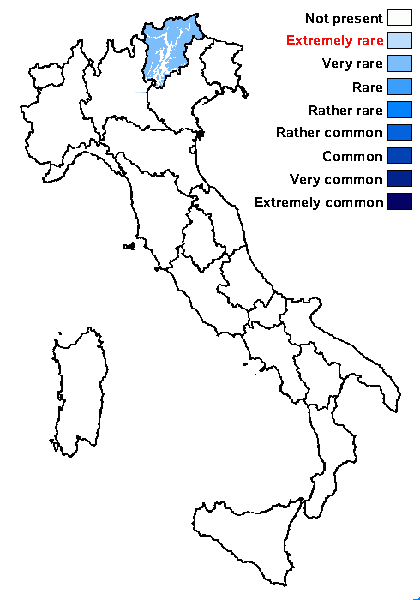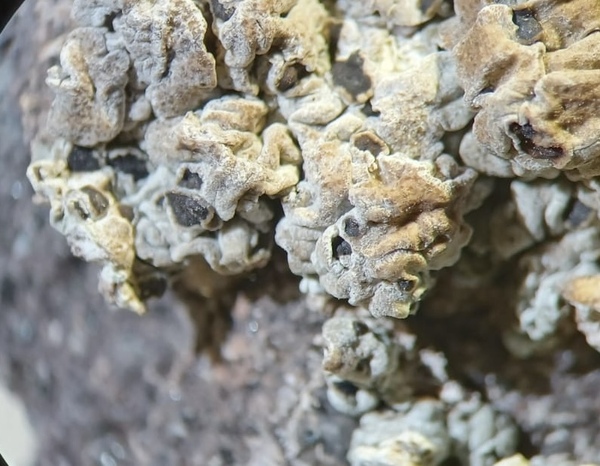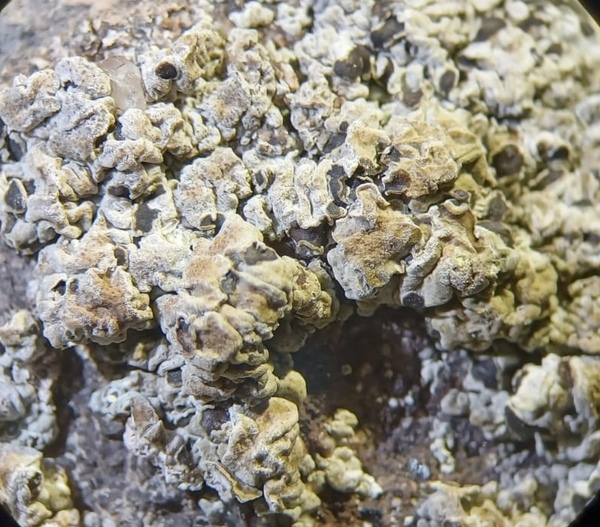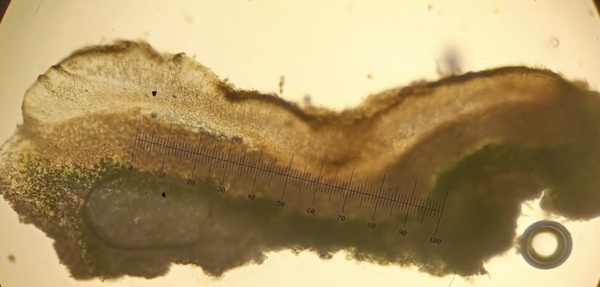Protoparmelia badia var. cinereobadia (Harm.) Hafellner & Türk
Stapfia, 76: 157, 2001. Basionym: Lecanora badia var. cinereobadia Harm. - Lich. Fr., 5: 1053, 1913
Synonyms:
Distribution: N - TAA (Nascimbene & al. 2022).
Description: Thallus crustose, episubstratic, warted-areolate, often up to 2 mm thick, pale grey-brown, ash-grey or almost white. Areoles mostly contiguous, very irregular in shape, 0.3-1.5 mm across, usually convex, matt. Cortex 20-30 µm thick, with a brown upper layer overlain by a very thick epinecral layer; medulla white or pale yellowish, I-. Apothecia lecanorine, at first immersed to adnate, later sessile, round or weakly angular by mutual compression, 0.4-1(-1.5) mm across, with a chestnut brown to dark brown, slightly concave to convex, glossy and epruinose disc, and a thick, entire to crenulate, usually persistent thalline margin. Thalline exciple corticate, c. 45 µm wide, with fine granules soluble in K; proper exciple poorly delimited, brown in outer part, colourless within, forming a 40-100 µm thick cupular layer below the hypothecium; epithecium olive-brown to yellowish brown, without granules, 10-20 µm thick; hymenium colourless, 50-70 µm high; paraphyses coherent, branched in upper part, rarely anastomosing, 3-4 µm thick in lower part, the apical cells 4-6 µm wide, with pale brown walls and a dark brown cap; hypothecium colourless or pale yellow. Asci 8-spored, clavate, approaching the Lecanora-type, with a well-developed amyloid tholus and a distinct, non-amyloid axial mass. Ascospores 1-celled, hyaline, oblong-ellipsoid to fusiform, with pointed apices, 10-19 x 4-7(-8) µm, the wall to 0.3 µm thick. Pycnidia immersed, black around the ostiole. Conidia straight, acicular, 6-9(-11) µm long. Photobiont chlorococcoid. Spot tests (better visible on microscopic sections): medulla K- or K+ pale yellow, C-, KC+ fleeting orange-red, P-. Chemistry: unknown.Note: this name has been used for any morph of P. badia with an ash-grey to whitish thallus, but its application was probably not consistent with the original concept (grey morphs with a thick, rough thallus, medulla reacting KC+ orange-red, and apothecia mostly smaller than 1 mm in diam.). According to Roux & coll. (2014) this variety occurs on weakly to moderately calciferous siliceous rocks from the montane to the nival belt.
Growth form: Crustose
Substrata: rocks
Photobiont: green algae other than Trentepohlia
Reproductive strategy: mainly sexual
Poorly known taxon in need of further study
Commonnes-rarity: (info)
Alpine belt: very rare
Subalpine belt: very rare
Oromediterranean belt: absent
Montane belt: very rare
Submediterranean belt: absent
Padanian area: absent
Humid submediterranean belt: absent
Humid mediterranean belt: absent
Dry mediterranean belt: absent

Predictive model
Herbarium samples


Juri Nascimbene CC BY-SA 4.0
Italia, Trentino Alto Adige, TN, Cavallazza Piccola - Parco di Paneveggio-Pale di San Martino
08.2022


Juri Nascimbene CC BY-SA 4.0
Italia, Trentino Alto Adige, TN, Cavallazza Piccola - Parco di Paneveggio-Pale di San Martino
08.2022


Juri Nascimbene CC BY-SA 4.0
Italia, Trentino Alto Adige, TN, Cavallazza Piccola - Parco di Paneveggio-Pale di San Martino
08.2022
Growth form: Crustose
Substrata: rocks
Photobiont: green algae other than Trentepohlia
Reproductive strategy: mainly sexual
Poorly known taxon in need of further study
Commonnes-rarity: (info)
Alpine belt: very rare
Subalpine belt: very rare
Oromediterranean belt: absent
Montane belt: very rare
Submediterranean belt: absent
Padanian area: absent
Humid submediterranean belt: absent
Humid mediterranean belt: absent
Dry mediterranean belt: absent

Predictive model
| Herbarium samples |


Juri Nascimbene CC BY-SA 4.0
Italia, Trentino Alto Adige, TN, Cavallazza Piccola - Parco di Paneveggio-Pale di San Martino
08.2022


Juri Nascimbene CC BY-SA 4.0
Italia, Trentino Alto Adige, TN, Cavallazza Piccola - Parco di Paneveggio-Pale di San Martino
08.2022


 Index Fungorum
Index Fungorum
 GBIF
GBIF



